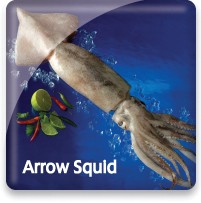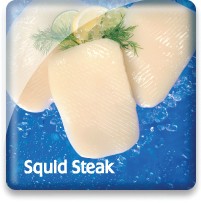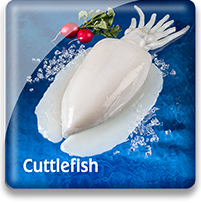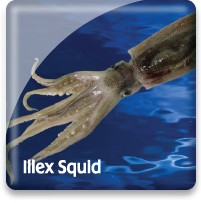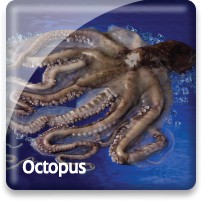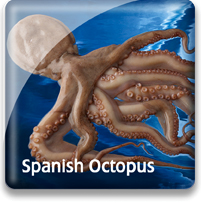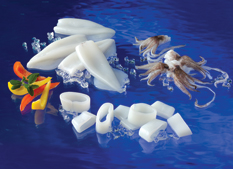
Loligo Squid

Market Name: Eating QualitiesSquid is a versatile product that is not strongly flavored, but considered by many to possess a kind of sweetness. The meat is tender and succulent. Frozen tubes should be ivory-white throughout and have no distinct odor.
   |
Description & CharacteristicsSea Port’s Premium Calamari (Squid) selection is made to meet the needs of all restaurants whether white tablecloth establishments, sports bars or take-out operations. When you select our premium Loligo spp. variety you will find a flavorful, tender offering ready for your recipes to please the most discerning palate of your guests. Squid, also called calamari, is a cephalopod mollusk with eight arms, two tentacles and a tubular shaped body that narrows to a point and has two fleshy wings along the rear part of the body. Squid swim tail-first by pumping water through valves located near their head. The shells have evolved into a small bone or pen inside the body. Like octopus and cuttlefish, they are cephalopods. There are many species in all seas, ranging in length from one inch to the Chilean giant squid of six feet and one hundred pounds. Even larger monsters are thought to live in very deep water. Squid grow fast and live only 12 to 14 months. Squid has excellent shelf life if handled with reasonable care. It is little affected by freezing, and the texture is unchanged even if the flesh is frozen and thawed a number of times. Fresh squid should have a sweet smell. It becomes rather pungent with age. Skin spots and color are not reliable guides to quality. The tentacles, wings and mantle (body) are all edible. There is a thin, soft skin covering the body and wings, which is usually removed before cooking. The skin changes color dramatically after the squid is caught. This is a natural process and is not a symptom of decomposition. Squid may be “bleached” by soaking it in iced water. This reduces the color changes and whitens the skin.
Squid is processed into tubes, rings and strips. Steaks, circular pieces cut from the mantles of large squid and usually tenderized with a needle machine, are also produced as a retail trade alternative to expensive abalone steaks. Fried calamari has become a mainstay on many restaurant menus, which has contributed to an explosion in domestic usage. A great deal of squid is frozen whole for bait, used by both sport fishermen and commercial line fishermen.
More than 300 different types of squid that have been identified around the world.
Other Resources |
Handling Instructions for Loligo Squid
Loligo squid should be stored frozen at or below 0°F (-18°C) and then thawed properly when ready to cook. Loligo squid should be Stored in the freezer in the original package or in a plastic wrap or a tight fitting plastic bag for product that has been removed from the original packaging. This will help prevent freezer burn (dehydration). Our loligo squid has an 18 month IQF and a 24 month block frozen shelf life. Links to proper seafood handling instructions: NOAA - Fish Watch: Handling Seafood and A Consumer Guide to Safe Seafood Handling.
Thawing Loligo Squid
Loligo squid should be thawed under refrigeration between 33 and 39°F until it is completely thawed. The thawing time is dependent upon if the squid is IQF or block frozen. IQF squid will thaw within 24 hours and block frozen will take up to 48 hrs. This thawing technique is preferred to preserve product moisture and flavor, however, IQF squid can be run under cold water and thawed within minutes. Block frozen squid can be placed in a tight fitting plastic bag and submerged in a cold water bath to expedite thawing.
Important Instructions for Loligo Squid
Thawed loligo squid should be used immediately or within 1-2 days due to the fact that squid in general has a relatively short thawed shelf life.
Cooking Tips
Loligo Squid should be cooked very quickly to avoid becoming rubbery in texture (two minutes or less at high heat). If your recipe calls for a slow cook process or you want to include loligo squid in a seafood cioppino, then be sure to cook it for 20+ minutes to achieve tenderness. Link to cooking tips and recipes.
China
With more than 1.3 billion people, China is today the world’s most populous country. With a growing economy fueling an appetite for seafood, China has begun importing seafood for in-country consumption, as well as exporting a great deal of its production. In fact, since 2002, China has continued to export more fish and fishery products than any other country in the world, with Japan, the United States, and the Republic of Korea as its main export markets.
Chinese distant water fishing activities started in 1985 when China gained access to new fishing grounds through agreements with foreign countries. China operates vessels in West Africa, the North Pacific, and tuna longline vessels in the South Pacific. In addition, squid are harvested in the Japan Sea, the South Atlantic, the Indian Ocean, and the North Pacific under Chinese-flagged vessels. Squid is also imported directly from India and Pakistan for processing.
Carp are also commercially important, as are bream, shad, eel, catfish, rainbow trout, salmon, whitebait, mullet, mandarin fish, perch, sturgeon, and murrel (snakehead). Commercial shellfish include Saltwater & freshwater shrimp, river crabs, and mollusks such as mussels, clams, oysters, and freshwater snails.
Thailand
With more than 1,550 miles of coastline, Thailand—officially, the Kingdom of Thailand—has become one of the world’s leading seafood suppliers. Primary seafood products from Thailand include cultured (farmed) shrimp sold in various value-added forms as well as canned seafood—predominantly tuna.
With a focus on constant improvement of shrimp farming techniques to reduce impacts on the environment, as well as the development of new, value-added products, Thailand has emerged over the years as one of the leaders in this beloved seafood category.
In the tuna category, Thailand is a major global producer of canned tuna, much of it caught by vessels from other countries that bring it, frozen, to Thailand to be canned.
Vietnam
With a coastline of 2,140 miles, as well as numerous rivers and lakes, Vietnam has had a long tradition of fishing and a culinary tradition that includes finfish, shellfish, and molluscan shellfish.
Bordering China in the far North, and Laos and Cambodia in the middle and Southern regions, the country—known officially as the Socialist Republic of Vietnam—is divided into 58 provinces, and includes several major sea ports.
With seafood production surpassing USD $6 billion in 2012, seafood—both cultured and wild—represents an important export for this developing country.
Major seafood exports from Vietnam include cultured and wild shrimp: Black Tiger prawns and Penaeus vannamei are grown in Southeast Vietnam, and small white and pink shrimp are still commercially caught in the South China Sea off the southern coast.
In addition, Vietnam is becoming known for its high-tech seafood processing industry, adding value to commercially harvested and farmed fish and seafood.
Species that are commercially caught include Grouper, Red Snapper, Red Mullet, Tuna, Swordfish, and Barramundi—which are the major species that are exported to Australia, the United States, and the EU. Vietnam is also a major producer of farmed Tilapia, and two species of Pangisius (boucourti and hypothalamus). Squid and octopus, as well as various species of lobster and crab and molluscan shellfish are also major export products as well as products consumed in-country.
Go Blue! Seafood Sustainability Spectrum*Click here for an explanation of our Sustainability Spectrum 
Sustainability AssessmentBecause most Loligo Squid species have relatively short life spans and grow to reproductive age quickly, their populations are thought to be somewhat resilient to moderate levels of fishing pressure. The short life span and unpredictable nature of factors such as egg survival and the influence of environmental conditions make it difficult to assess most all squid populations using conventional stock assessment methods. In many cases, effective management of squid fisheries is lacking. Additionally, certain squid fisheries also carry a risk of severe habitat impacts from the fishing gear used (e.g., bottom trawling on sensitive habitats such as cobble and coral). Improvements in data collection and management are necessary to mitigate the risk of negatively impacting populations through overharvesting, particularly in light of the fact that recent declines in “traditional” fish stocks have fueled increased interest in squid fisheries worldwide.

Environmental Impact: Moderate to moderately highBecause population fluctuations seem to be closely tied with environmental factors, year to year squid biomass is difficult to accurately predict. Management of the resource is inadequate in many major squid fisheries. Additionally, some squid are caught by bottom trawling, which can negatively impact ocean floor habitats.
Sustainability Improvements NeededImprovements in the amount and types of data collected are needed in order to accurately establish fisheries trends and further develop stock assessment models specific to squid. Specific management measures for squid also need to be developed in many fisheries in order to prevent overfishing. Research into mitigation of habitat impacts by bottom trawling (e.g., gear modifications) is also needed.
Actions that Sea Port is UndertakingSea Port is requiring that their suppliers provide fishing vessel identification (when available), catch methodology, and catch area information. In doing so, Sea Port may be encouraging the Loligo Squid fisheries to collect additional harvest data which could set the stage for future fishery management improvements. Sea Port believes that, in aggregate, choosing from a diverse variety of seafood is better for sustaining the world’s seafood resources and that the short lived and highly fecund (resilient to fishing pressure) Loligo Squid should be a part of this variety.We created the sustainability assessments for each of our seafood items in order to reveal the existing and potential environmental impacts and risks that are associated with producing them for human consumption. This allowed us to establish the starting position for each of our seafood items along our progressive Go Blue! Seafood Sustainability Spectrum®. These assessments are only a single snapshot in time and because of this, we will continue to assess and update the critical sustainability needs associated with our supply sources and issue updates to the Go Blue! Seafood Sustainability Spectrum® as needed. There is a growing global awareness for the need to assure the sustainability of farmed and wild caught seafood and because of this; all around the world positive changes are rapidly occurring at all levels of the seafood supply chain. We will continue to spread this growing awareness and work with our many industry partners to improve the sustainability of all seafood, which we believe is the ideal protein of choice to feed an ever growing world population. Our Go Blue! Seafood Sustainability Spectrum® serves as our compass and yardstick as we strive to move all our products forward to becoming more sustainable. Please join us in this committed quest and Catch Our Wave® to sustainability by choosing a diverse variety of responsibly produced seafood as part of your diet.
|


